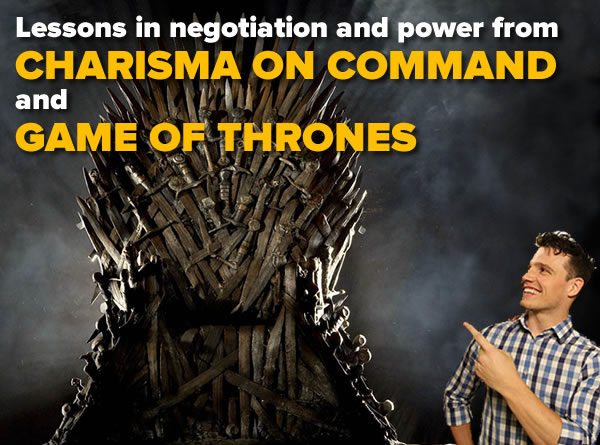
If you want to get better at handling social situations and want to be entertained at the same time, take a look at Charlie Houpert’s Charisma on Command YouTube channel, where he says his goal is to help you become “your most confident, charismatic self”. He does breakdowns of techniques used by influential people, from politicians Barack Obama and Donald Trump (while not a fan of Trump, he made a $1000 bet that Orange Julius Caesar would win the election based on his messaging), to fighters Muhammad Ali and Bruce Lee, to actors Robert Downey Jr., Jennifer Lawrence, and Will Smith, and even supernerds Neil deGrasse Tyson and Hank and John Green, the Vlogbrothers.
Charlie’s a big fan of the TV series Game of Thrones, and as a result, he’s used their characters as a studies in charisma and power dynamics in social situations. While you may be a bit leery of following the motivations of fictional TV characters written by screenwriters with dubious ideas, the examples that they provide and the lessons Charlie extracts from them make for good viewing and even better lessons. Here’s a roundup of the seven (so far) Charisma on Command videos based on Game of Thrones characters…
Why Tyrion can’t be killed
Key lesson: Influence is not about convincing people to want different things from what they already want. It’s about showing them that the way to get what they already want is by following you.
Why Tyrion will win the game of thrones
Key lesson: In situations where there’s a power dynamic, the person with the greater power is the one with the conviction that they have choices, and then…
- Controls when things occur
- Establishes who matters more
- Controls what is focused on
- Controls where the interaction happens
Why the Starks will always get betrayed
Key lessons: Good intentions are never enough for a leader. You also have to:
- Know what other people want, what motivates them, and what they (and not you) would do in a given situation.
- Motivate people by aligning their interests with yours.
- When giving instructions, explain not just what to do, but why.
- To get people to do things, explain the heaven if they do, and the hell if they don’t.
Game of Thrones: How power really works
Key lessons: A frame is the set of all the unstated beliefs and assumptions that give context to a situation or interaction. Control the frame, and you control the situation or interaction.
- The key to convincing people of something is to bring them into your frame.
- Every insult is a frame game, and fighting the frame of an insult is a losing game. Turn the frame and take control.
- Whoever controls the options has the power. Move the frame so that you have more options. Everything that’s possible changes based on your creativity.
How Littlefinger controls the game of thrones
Key lessons: Don’t emulate Game of Thrones’ most Machiavellian still-living character, but do learn from his tricks and make sure no one pulls them on you:
- Instead of being pushy when trying to persuade someone, he plants the seed of the idea in his mark’s head. This leads them to come to the conclusion he wants on their own, making them feel in control and that they came to the decision themselves.
- He understands that people want to appear and feel in control even though they don’t really want to be in control. He tolerates slights and insults and avoids the usual trappings of power because he’d much rather focus on having control rather than the appearance of having control.
- To him, nothing is sacred, so honor, sentimentality, and morality are not obstacles to him. This has let him get his way for the past six seasons, but it will likely be his undoing this year.
How Tywin Lannister commands respect
Key lessons: Power doesn’t from telling people who have power, but by sub-communicating that fact. Lannister’s techniques are:
- Using loudness and silence effectively.
- Using stillness and moving calmly instead of flinching and twitching.
- Using relative position — speaking from a physically higher location — to establish who’s boss.
- Controlling when a conversation begins and ends.
3 surprising steps to influence anyone
Key lessons:
- Physically put yourself by their side.
- Get people to talk about things that they’re interested in and that they care about.
- Get people to open up by showing a little vulnerability.
- Show interest in people’s opinions.
- Practice active listening, get to know what makes people tick, and express empathy (and remember, empathy isn’t agreeing with someone, but seeing the world through their eyes).